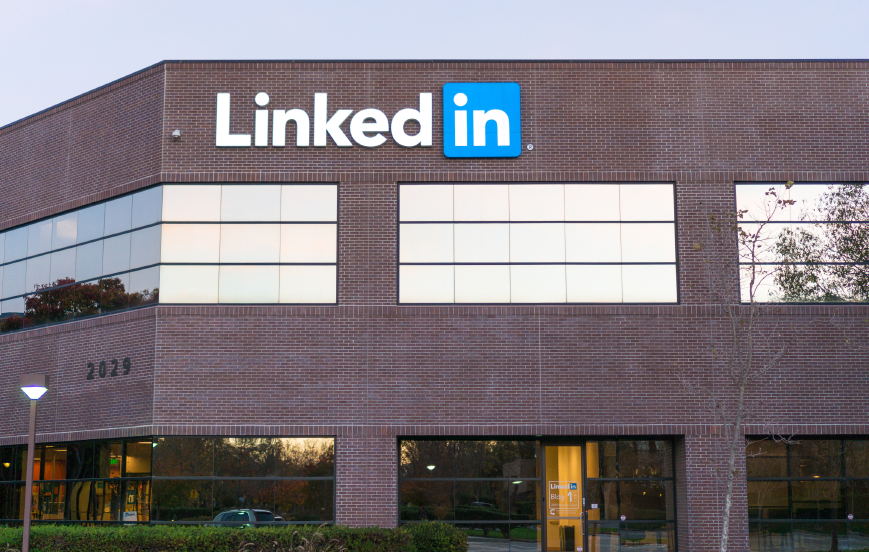
Hot on the heels of Instagram and Twitter’s recent newsfeed changes, recruiters can expect another important social media platform to look very different this week. As of May 16, LinkedIn is phasing out a number of its higher education features as part of a dramatic revamp of its student services.
Previously, the professional social networking site had sought to provide a comprehensive service which encompassed college decision –making for prospective students, job search tools for graduates, and alumni relations.
Now, the site will be focusing more on helping current students find jobs, with the launch of the brand new LinkedIn Student App, and will be discontinuing a number of previous features. While the specialized university pages available to schools will remain for now, there are unconfirmed reports that they will be merged with ordinary company pages later this year.
So where does this news leave your social media marketing campaigns? Read on to find out how schools should be refining their current strategies to continue to get the most out of their LinkedIn accounts.
Why is LinkedIn Revamping its Higher Ed Features?
While LinkedIn has become a trusted and reputable resource among adult professionals, the site has long struggled to effectively capture the attention of the student market. This was supposed to change in 2013 with the introduction of LinkedIn University Pages, which aimed to position the site as an authority in the college decision-making process.
Further features were introduced in 2014 to enhance the process, but the platform is still used sparingly by students, with a November 2014 survey by market research firm Chegg revealing that just 11% of high school seniors were using LinkedIn for researching colleges, which is even less than highly visual ‘niche’ sites such as Snapchat and Vine:
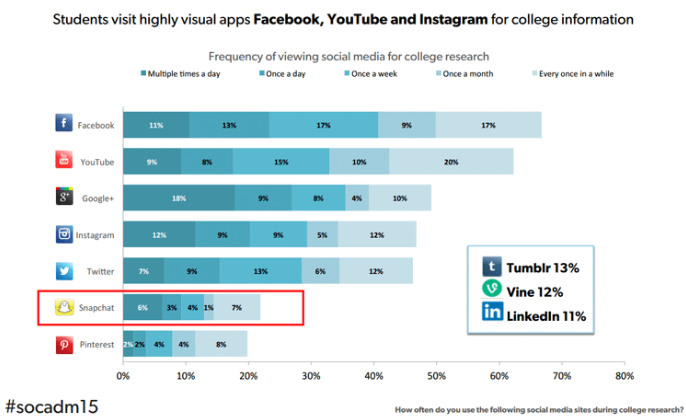
The LinkedIn Students App represents a new attempt to gain ground with the younger market by focusing solely on employment opportunities. In an email to University Page administrators, LinkedIn explained that, “We’ve heard from our student members that moving into the professional world is one of their biggest challenges. That’s why we’re launching a student-focused mobile app that will help students explore career paths and –ultimately land- a job they’ll love.”
Some of LinkedIn’s Online Student Recruitment Tools Will be Discontinued
Unfortunately, the revamp of LinkedIn’s student services will deprive schools of some unique online student recruitment tools that the company had previously introduced. Prospective students checking out schools on LinkedIn had previously been given access to a University Hub page, which included a broad range of features which are all now being discontinued, including:
- Field of Study Explorer, which helped students to explore a range of different study areas as well as explore the careers of successful graduates in specific fields.
- University Finder, which allowed students to refine their university search based on location, field of study, and even by the amount of alumni employed by a specific company, such as Google or Microsoft.
- LinkedIn’s University Rankings, which ranked schools in different subject areas based on career outcomes for graduates.
- Decision Boards, a useful feature which allowed students to amalgamate all their findings from the above tools into a board to help them compare choices. Individual decision boards could even be shared among peers for discussion and advice.
Example: The below example shows the University Finder feature in action. As you can see, the feature suggests universities for a very specific request, in this case a student looking for a business career based in the US with a company like Amazon. The student can then add each of these universities to their decision board. While there is obvious potential for these tools to be useful, they failed to capture the imagination of prospective students.
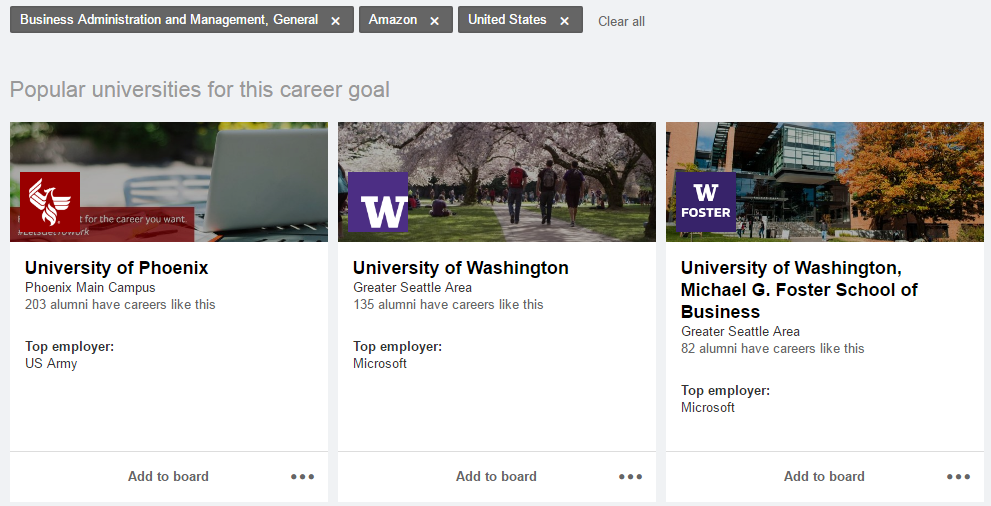
Each of these features seemed to offer great possibilities when they launched, and some recruiters may see the decision as a missed opportunity for the site. However, the fact remains that the University hub wasn’t capturing the imagination of millennials, and a rethink may have been necessary.
How Schools Can Maximize the Potential of the New LinkedIn Student App
So how does the new app work? Once a student signs up and enter details of their college major, they are presented with a series of personalized “cards”, in a similar manner to magazine aggregation apps like Flipboard. The cards cover a range of information including suggested career options for their field of study, job openings, articles and recommended alumni and company pages for the student to browse.
The articles available on these pages could become particularly important for schools, as it is the only immediate way to get their LinkedIn page featured in the app. If you are looking to boost the chances of your content being featured, it might be an idea to focus on promoting articles relating to popular fields of study, with a particular emphasis on useful career development advice.
Example: John Cabot University is an English-speaking liberal arts College based in Rome. In this post from their LinkedIn page they are promoting a blog entitled “How to Showcase Your Study Abroad Experience on Your Resume.” This kind of career-focused information for students could be the kind of content that LinkedIn finds useful for the new students app, and could help schools to remain part of the conversation.

The card format may also open up the opportunity for sponsored ads in the future, which could be worthwhile for recruiters to consider if the format catches on, given the wealth of personalized information LinkedIn have at their disposal to facilitate targeted campaigns. However, as it is specifically targeted towards current university students, it might be more useful for schools promoting postgraduate programs or professional development training than those looking to recruit school leavers.
It’s important to emphasize that this shift in their student targeting strategy does not necessarily mean that LinkedIn is no longer eager to work with universities. As soon as the new student app had launched, the site were quick to update their Higher Ed Professionals page with tips for schools to reach students through the new platform.
By far the most intriguing possibility the app offers for schools is the option to partner with LinkedIn, which would mean that your current students see a personalized version of the app with content specifically tailored for your school, and featuring job postings from your career portal. LinkedIn also advise providing a link to the app on your website, and even offer a downloadable marketing toolkit which includes flyers and other materials for promoting the app around your college. While the immediate benefits of this will be felt more by career services departments than recruiters, it can be extremely valuable in helping promote your school’s reputation as a career focused institution, and strengthening your relationship with current students and alumni.
Refining Your University Page to Continue Getting the Most Out of LinkedIn
While there are now a less diverse range of tools for higher education social media marketing on LinkedIn, the site still offers a unique platform for student recruitment. One of its biggest advantages is how well it links schools with their alumni, allowing prospective students a glimpse at what their possible future might hold if they choose to apply.
Example: On the University of Phoenix’s page below, you can see how the site prominently features information about the careers of alumni just underneath the header bar, as well as details of notable graduates in the right sidebar, which can be a great way of showing students the possibilities studying at your school could open up for them.

The alumni recommendations section will also remain on the site .This feature allows your alumni to contribute testimonials about their time at your school and how it helped their career, and many universities have found it extremely valuable in generating positive publicity for their recruitment initiatives.
Example: This glowing testimonial from an alumnus of South New Hampshire is a good illustration of the kind of valuable user-based content LinkedIn’s alumni recommendations can generate.
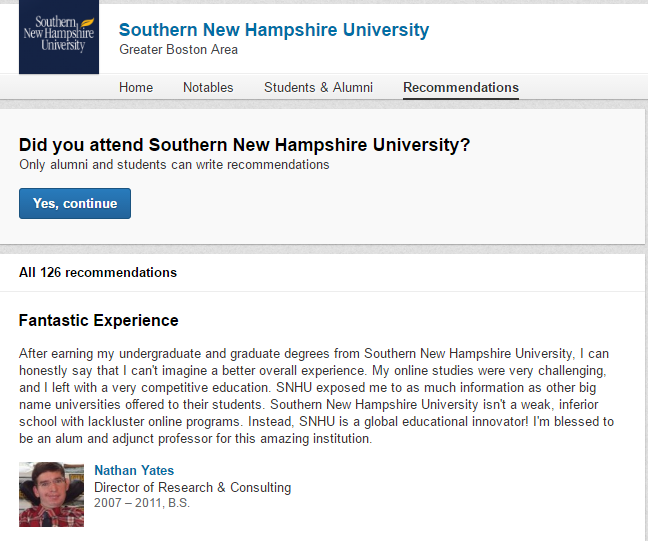
If schools are to continue getting the most of their LinkedIn presence, it would be wise to refocus on content promoting alumni successes, perhaps establishing connections with notable graduates and even making them a part of your campaigns.
Example: As part of an innovative recruitment campaign by Royal Roads University, prospective students are given the chance to connect with some of the school’s alumni as ‘Future Mentors,’ who will answer any questions they might have about studying there. They have the option of connecting through LinkedIn, giving the school the opportunity to show off their graduates’ successes.


Several other LinkedIn tools could also help to compensate for any reduction in audience reach you may suffer as a result of the changes. Showcase pages, which allow you to create specific pages targeted to particular audiences, can be used to highlight individual programs and campaigns, and could help you to create more targeted content for prospective students who are still using the site. LinkedIn Groups can also be useful for helping to segment your audience.
Above all, continuing to promote professionally focused content on the site, such as articles about academic research, notable alumni achievements, and useful career information for graduates will be crucial in keeping your followers engaged. In addition, publishing on the site’s news aggregation app LinkedIn Pulse can be a great way to get your content shared by influential users and increase the likelihood of your posts reaching the right audience.
Example: This post from Arizona State University President Michael Crow has managed to gain some traction through Pulse, trending on the main page of the education channel and attracting over 1,000 views. Having renowned faculty members publishing content on Pulse will also help to promote your school.
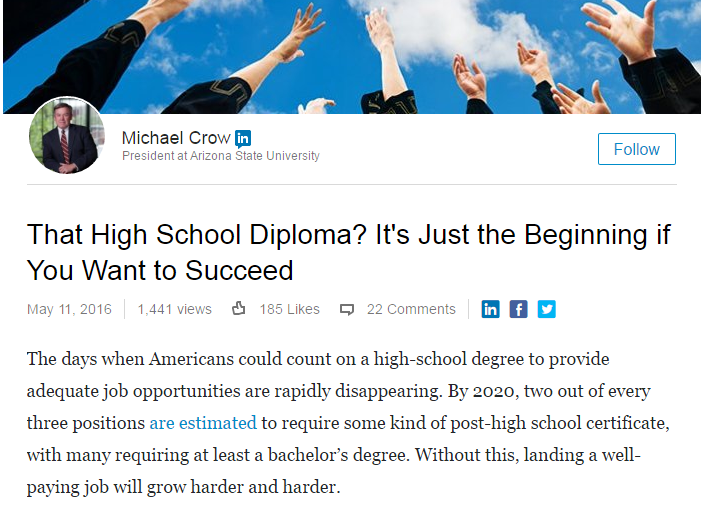
The Future of Education Lead Generation on LinkedIn
It will become increasingly vital to stay on top of your LinkedIn strategy in the near future, with further changes set to come before the year is out. Unconfirmed reports suggest that the site will be merging university pages with regular company pages by the end of 2016. Right now, there is no way of knowing what form this change will take, but one positive result could be access to better analytics tools for university page administrators.
At present, University Pages do not provide data regarding segmented followers, clicks or impressions, but migrating to the same platform as company pages will allow them to make use of its comprehensive analytics tab, which tracks numerous different metrics relating to updates, followers, and visitors.
While maintaining your school’s visibility on LinkedIn may become more difficult in the future, it is still a worthwhile platform for education lead generation. Even though the percentage of prospective students using the platform for college research is small, those that do tend to be highly focused, ambitious individuals keen on establishing a professional brand for themselves early, and as a result, are often very desirable recruits.
By adjusting your own LinkedIn strategy to match the sites new, more career-focused approach, and engaging current students and alumni to strengthen your school’s brand and build loyalty, you can still use the platform to reach a small but coveted audience.






